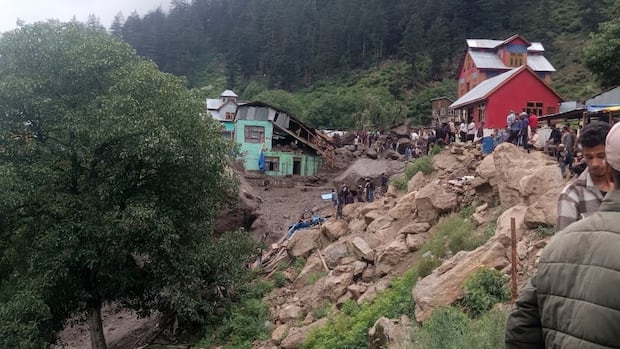A Pakistani official says the death toll from flash floods in the country’s northwest has risen to 274 after rescuers recovered dozens of bodies from the rubble of collapsed houses.
Mohammad Suhail, a spokesperson for the emergency service, said 54 bodies were found on Sunday in Buner, a mountainous district in Khyber Pakhtunkhwa province, where torrential rains and cloudbursts triggered massive flooding on Friday.
He said several villagers remain missing, and search efforts are focused on areas where homes were flattened by flood.
Residents in Buner accused officials of failing to warn them to evacuate the rain triggered flooding and landslides. There was no warning broadcast from mosque loudspeakers, a traditional notification method in remote areas.
The government said that while an early warning system was in place, the sudden downpour in Buner was so intense that the deluge struck before residents could be alerted.
Lt. Gen. Inam Haider, chair of the National Disaster Management Authority, told a hastily convened news conference in Islamabad that Pakistan was experiencing shifting weather patterns because of climate change. Since the monsoon season began in June, Pakistan has already received 50 per cent more rainfall than in the same period last year, he added.
He warned that more intense weather could follow, with heavy rains forecast to continue this month.
‘Lives could have been saved’
Asfandyar Khan Khattak, director-general of the Provincial Disaster Management Authority, said there was “no forecasting system anywhere in the world” that could predict the exact time and location of a cloudburst.
Mohammad Iqbal, a schoolteacher in Pir Baba village, said the lack of a timely warning system caused casualties and forced many to flee their homes at the last moment.
“Survivors escaped with nothing,” he said. “If people had been informed earlier, lives could have been saved and residents could have moved to safer places.”
A mother and father recount the moment they learned of the flash flood and landslide that hit the Himalayan village of Dharali on Tuesday — and how they spoke with one of their children before the phone connection was lost and they weren’t heard from again.
Idrees Mahsud, a disaster management official, said Pakistan’s early warning system used satellite imagery and meteorological data to send alerts to local authorities. These were shared through the media and community leaders. He said monsoon rains that once only swelled rivers now also triggered urban flooding.
Suhail, of the local emergency services, said more than half the damaged roads in the district had reopened by Sunday, allowing vehicles and heavy machinery to reach cut-off villages.
Crews were clearing piles of rocks and mud dumped by the floods. They were still using heavy machinery to remove the rubble of collapsed homes after families reported that some of their relatives were missing.
In one of the deadliest incidents, 24 people from one family died in the village of Qadar Nagar when floodwaters swept through their home on the eve of a wedding. The head of the family, Umar Khan, said he survived the floods because he was out of the house at the time. Four of his relatives have yet to be found, he added.
More deluges, possible landslides expected
Authorities have warned of more deluges and possible landslides between now and Tuesday, urging local administrations to remain on alert.
Higher-than-normal monsoon rains have lashed the country since June 26 and killed more than 600.
Pakistan is highly vulnerable to climate-induced disasters. In 2022, a record-breaking monsoon killed nearly 1,700 people and destroyed millions of homes.
The country also suffers regular flash floods and landslides during the monsoon season, which runs from June to September, particularly in the rugged northwest, where villages are often perched on steep slopes and riverbanks.
Heavy rain brought flash flooding and mudslides to northern India, washing away homes and leaving more than 100 people missing.
Experts say climate change is intensifying the frequency and severity of such extreme weather events in South Asia.
In Indian-controlled Kashmir, torrential rains triggered flash floods in two villages in Kathua district that killed at least seven people and injured five overnight, officials said. Rescue and relief operations are underway.
In Kishtwar district, teams are continuing their efforts in the remote village of Chositi, looking for dozens of missing people after the area was hit by flash floods three days earlier. At least 60 were killed and some 150 injured, about 50 of them critically.
Thursday’s floods struck during an annual Hindu pilgrimage. Authorities rescued over 300 people, while some 4,000 pilgrims were evacuated to safety.


